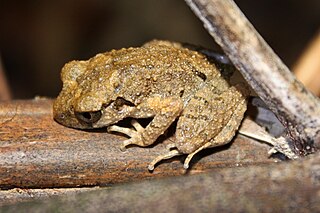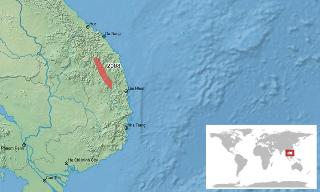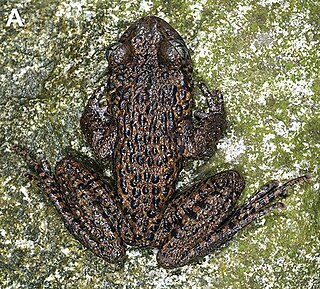
Scutiger sikimmensis is a species of toad in the family Megophryidae. It is found in northeastern India, Nepal, Bhutan, and Tibet. Many common names have been coined for this species: Sikkim lazy toad, Sikimmese pelobatid toad, Sikkim high altitude toad, Sikkim spade foot frog, Blyth's short-limbed frog, and Sikkim snow toad. It is very common in the high altitudes of Sikkimese Himalaya.
Oreobates zongoensis is a species of frog in the family Strabomantidae. It is endemic to Bolivia from Valle del Zongo, in Pedro Domingo Murillo Province.

Engystomops coloradorum, also known as Colorado dwarf frog, is a species of frogs in the family Leptodactylidae. It is endemic to the Pacific lowlands and foothills of the Andes in the Pichincha and Santo Domingo de los Tsáchilas Provinces, Ecuador.
Leptobrachella mjobergi is a species of frogs in the family Megophryidae. It is endemic to Borneo where it is found in Kalimantan (Indonesia), Brunei, and Sarawak (Malaysia).
Leptobrachella kajangensis, also known as the Kajang slender litter frog, is a species of amphibian in the family Megophryidae. It is endemic to Malaysia and only known from its type locality, a small cave near the top of Gunung Kajang, on Tioman Island, a small island located 32 km off the east coast of Peninsular Malaysia.

Leptobrachella liui, also known as Fujian Asian toad or Fujian metacarpal-tubercled toad, is a frog species in the family Megophryidae. Originally described from Chong'an in Fujian, it is now known to be widely distributed in southern and southeastern China from Zhejiang and Fujian west to Guizhou and Guangxi.
Leptobrachella oshanensis, also known as the Oshan metacarpal-tubercled toad or pigmy crawl frog, is a frog species in the family Megophryidae. It is endemic to southern–central China (Guizhou, Hubei, Gansu, and Sichuan provinces as well as the municipality of Chongqing). Its type locality is Mount Emei (Chinese: 峨嵋山; pinyin: Éméi Shān; Wade–Giles: O2-mei2 Shan1). The same mountain has given the species its name. It has also been reported from Thailand and Laos but these are now considered to represent Leptobrachella minimus.

Leptobrachella tuberosa, also known as the granular toad, is a species of frog in the family Megophryidae. As currently known, it is endemic to the Central Highlands of Vietnam in Gia Lai, Quảng Nam, and Thừa Thiên–Huế Provinces. Its true range is probably wider as suitable habitat extends further north and east, reaching northeastern Cambodia and southeastern Laos. The specific name tuberosa is derived from the Latin tuberosus, meaning "full of protuberances".
Ptychadena harenna is a species of frog in the family Ptychadenidae. It is endemic to Ethiopia and only known from its type locality at the foothills of the Bale Mountains, in the Bale Mountains National Park. The locality is within the Harenna Forest, and common name Harenna Forest grass frog has been coined for it.
Leptobrachella baluensis is a species of amphibian in the family Megophryidae. It is endemic to montane northern Borneo in Sabah and Sarawak (Malaysia) and northern Kalimantan (Indonesia). It has been in synonymy with Leptobrachella mjobergi, but is now treated as a valid species.
Leptolalax tamdil is an anuran amphibian belonging to the family Megophryidae. It is so far reported only from Tam Dil lake, Mizoram, India. It is a small frog, but medium-sized among Leptolalax species; the male measuring 32.3 mm, and female 31.8 mm. The species is diagnosed with unique features such as eyelids with tubercles, distinct tympanum and supratympanic folds, undilated toe tips with dermal fringes, long hind limbs, and distinct color patches.
Leptolalax khasiorum is a species of frogs belonging to the genus Leptolalax. It is so far reported only from the type locality, from the subtropical wet forests of Mawphlang in Khasi Hills, Meghalaya, India. It is a small amphibian; the male measuring 25.6 mm, and female 32.5 mm. The species is diagnosed with unique features such as eyelids with tubercles, distinct tympanum and supratympanic folds, undilated toe tips with dermal fringes, dorsum with dark blotches, flanks with large dark blotches, dark tympanic mask, limbs with dark cross-bars, and distinct color patches.

Raorchestes coonoorensis, also known as the Coonore bushfrog or Coonoor bush frog, is a species of frogs endemic to the Western Ghats, India. It is reported from its type locality, Sim's Park in Coonoor, with an additional observation from Kothagiri; both locations are in the state of Tamil Nadu. Its altitudinal range is 1,780–1,850 m (5,840–6,070 ft) asl.
Polypedates subansiriensis is a species of frogs in the family Rhacophoridae. It is endemic to Northeast India and only known from its type locality, Soro village in the eponymous Lower Subansiri District, Arunachal Pradesh state. It is sometimes known as the Subansiri's tree frog or Subansiri tree frog.
Scutiger wuguanfui is a species of toad in the family Megophryidae. It is endemic to Tibet and only known from its type locality in the Medog County. The specific name wuguanfui honours Wu Guanfu, a Chinese herpetologist. Common names Wu's lazy toad, Medog lazy toad and Medog cat-eyed toad have been coined for it.
Leptobrachella lateralis is a species of frog in the family Megophryidae. It was first described by John Anderson (1871), who originally named it Ixalus lateralis. The holotype is lost and its exact origins are uncertain, but it was likely collected "from some portion of the surrounding region [of Bhamò]", Myanmar. It is only known with confidence from the region of its type locality and from Nagaland in Northeast India. Its range might extend into Yunnan, China. It is sometimes called Nagaland Asian toad or Nagaland leaf litter toad.

Oreolalax longmenmontis is a species of frog in the family Megophryidae. It is endemic to Sichuan, China, and is only known from its type locality in the White River National Nature Reserve, Pengzhou City. The type locality is in the central part of the Longmen Mountains. Accordingly, common name Longmen Mountains toothed toad has been proposed for this species.
Leptobrachella bondangensis is a species of frog in the family Megophryidae. It is endemic to Central Kalimantan, in the Indonesian part of Borneo, and is only known from its eponymous type locality, Mount Bondang in the Murung Raya Regency. Common name Bondang dwarf litter frog has been coined for this species.

Leptobrachella suiyangensis, also known as Suiyang leaf-litter toad, is a species of frog in the family Megophryidae. It is endemic to Guizhou province in southern China and so far only known from Huoqiuba Nature Reserve, its type locality in the eponymous Suiyang County.
Gracixalus seesom, also known as the orange bush frog or orange bushfrog, is a species of frog in the family Rhacophoridae. It is endemic to northwestern Thailand and is known from the Kanchanaburi and Chiang Mai Provinces.







